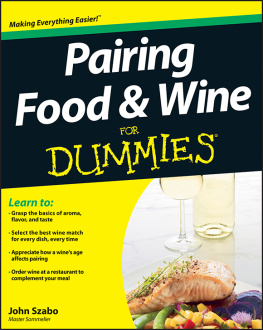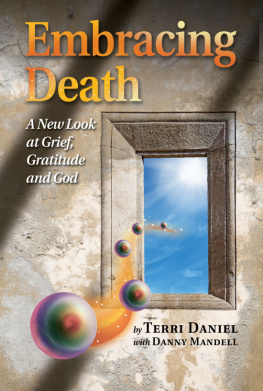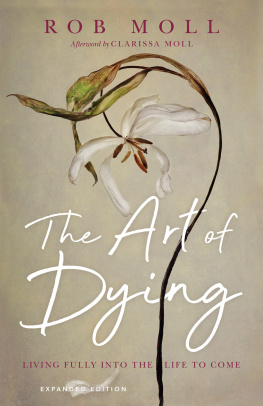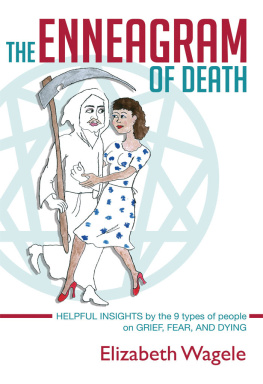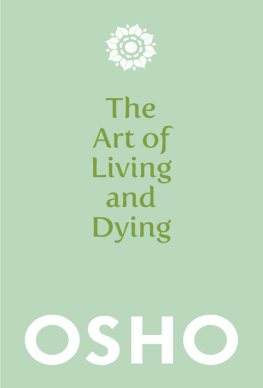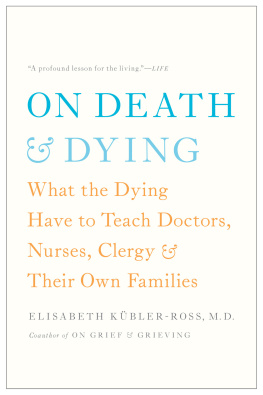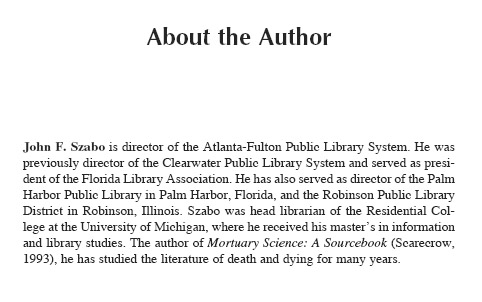1
Adolescents
Allen, Janet. Using Literature to Help Troubled Teenagers Cope with Endof-Life Issues . Westport, CT: Greenwood Press, 2001.
Baxter, Grant, and Wendy Stuart. Death and the Adolescent: A Resource Handbook for Bereavement Support Groups in Schools . Ontario: University of Toronto Press, 1999.
Bode, Janet. Death Is Hard to Live With: Teenagers Talk about How They Cope with Loss . New York: Bantam Doubleday Dell Books for Young Readers, 1993. Cartoon artwork by Stan Mack.
Bode uses personal stories, vignettes, graphics, and a direct discussion of death to present the issue to young adults. She covers funerals, violent deaths, parental and sibling death, and the myriad of feelings experienced by teenagers. Comments or explanations by professionals on various subjects are offered throughout the book. Bode also offers some treatment for issues of cultural and religious variations in approaching death, dying, and bereavement. References for recommended books and videos are presented in a narrative at the books conclusion.
Corr, Charles A., and David E. Balk. Handbook of Adolescent Death and Bereavement . New York: Springer, 1996.
Corr, Charles A., and Joan N. McNeil, eds. Adolescence and Death . New York: Springer, 1986.
Dower, Laura, and Elena Lister. I Will Remember You: What to Do When Someone You Love Dies: A Guidebook through Grief for Teens . New York: Scholastic, 2001.
In assisting teens in coping with death, Dower talks about being in a state of denial, keeping a grief journal, different types of grief, the role of ritual in grief, cultural expressions of grief (African American, Ancient Egyptian, Buddhist, Christian, Islam, Judaic, Native American), dealing with feelings, physical effects of grief, helping others grieve, remembering the loved one, aftershocks of grief, and finding routine again. She offers guidance for specific situations: parental loss, losing a friend, violent or sudden death, and so forth. Appendixes include reading lists, music, movies, and organizations with websites. Includes a bibliography and author biographies.
Finch, Stuart M., and Elva O. Poznanski. Adolescent Suicide . Springfield, IL: Charles C. Thomas, 1971.
Fitzgerald, Helen. The Grieving Teen: A Guide for Teenagers and Their Friends . New York: Simon & Schuster, 2000.
A certified death educator, Fitzgerald offers an incredibly thorough guide for teens dealing with death. She discusses reacting to the news of a death, support groups, the hospice movement, feelings of fear and anger, visiting the hospital, saying goodbye, funerals and related subjects, grief and bereavement, and recovery. The book answers some very specific questions teens may have about death, for example, what is death like for the dying person? What does a dead body look or feel like? Fitzgerald includes extensive discussion on feelings, grief, and the future following a death, and she offers stories from teens who have experienced a death and advice on being a friend to someone grieving. Includes a resource list, bibliography, and list of websites. Foreword by noted thanatologist Earl A. Grollman.
Footman, Marilyn E., and Pamela Espeland. When a Friend Dies: A Book for Teens about Grieving and Healing . Minneapolis, MN: Free Spirit Publishing, 2005. Originally published in 1994.
Straightforward and direct, this book stresses to teens that feelings of grief are normal and confirms that teens and adults grieve differently.
Giddens, Sandra, and Owen Giddens. Coping with Grieving and Loss . New York: Rosen Publishing Group, 2003. Rev. ed. Originally published in 2000.
Intended for high school audiences, this text addresses issues of loss, grief, mourning, and funerals. The authors discuss feelings of anger, guilt, depression, and acceptance often experienced by those grieving. They offer coping techniques and suggestions for recovery. Thoughtful chapters are included on violence in schools and the September 11, 2001, terrorist attacks. A brief glossary, organizations providing assistance to teens, and suggestions for further reading are included.
Gravelle, Karen, and Charles Haskins. Teenagers Face-to-Face with Bereavement . Englewood Cliffs, NJ: Julian Messner, a division of Silver Burdett Press, Simon & Schuster, 1989.
Gravelle and Haskins present seventeen adolescents and young adults who describe their grief experienced as teens following the deaths of family members and friends from causes ranging from cancer to automobile accidents to cystic fibrosis. The authors discuss what is different about adolescent bereavement and present a caring, sensitive treatment of the subject. The focus is on the feelings and experiences of teenagers and their methods of coping with grief. Subjects include personal relationships with the terminally ill, initial reactions to death, problems facing classmates and friends, coping with depression, feelings of guilt and anger, and renewing family life following the death of an immediate family member.
Grollman, Earl A., ed. Bereaved Children and Teens: A Support Guide for Parents and Professionals . Boston: Beacon Press, 1995.
In a collection of articles by prominent thanatology and death education experts, Grollman presents a comprehensive guide to bereavement in youth for parents, caregivers, teachers, clergy, and health care professionals. Topics covered include explaining death to young children, adolescent understandings of death, disenfranchised grief of children, talking to children about terminal illness, cultural and religious perspectives on death and children, treatments and therapies to help children cope with death, care of the dying child, special needs of bereaved children, and using film and drama to help children cope with death. A section on cultural and religious perspectives includes articles on issues among African American, Jewish, Protestant, and Catholic children.
Hogan, N. S. An Investigation of the Adolescent Sibling Bereavement Process and Adaptation . Chicago: Loyola University, 1987. Authors doctoral dissertation.
Hughes, Lynne B. You Are Not Alone: Teens Talk about Life after the Loss of a Parent . New York: Scholastic, 2005.
Hughes, who lost both of her parents at a young age, is the founder and director of the nonprofit Comfort Zone Camp, a place for grieving children. She, along with her campers, offers suggestions for coping with grief and moving beyond it through testimonials. Includes detailed information about the camp.
Irish, Jerry A. A Boy Thirteen: Reflections on Death . Philadelphia: Westminster Press, 1975.
Kuehn, Eileen. Death: Coping with the Pain . Mankato, MN: LifeMatters, 2001.
Intended for an elementary and junior high school audience.
LaGrand, Louis E. Coping with Separation and Loss as a Young Adult: Theoretical and Practical Realities . Springfield, IL: Charles C. Thomas, 1986.
McBride, Alfred. Death Shall Have No Dominion . Dubuque, IA: William C. Brown, 1979.
McBride, a Roman Catholic priest, offers death education for adolescents from a Catholic perspective.
Meyers, Karen, Mark J. Kittleson, and William Kane. The Truth about Death and Dying . New York: Facts on File, 2005.
The authors offer a guide to death and dying for teen audiences.
Millet, Edmund A. An Investigation among Junior Highs into the Understanding of Death and Dying and a Program Response . Boston: Boston University School of Theology, 1979.
This book was a project report associated with Millets pursuit of the doctor of ministry degree.
Morgan, John D., ed. The Dying and the Bereaved Teenager . Philadelphia, PA: Charles Press, 1990.


